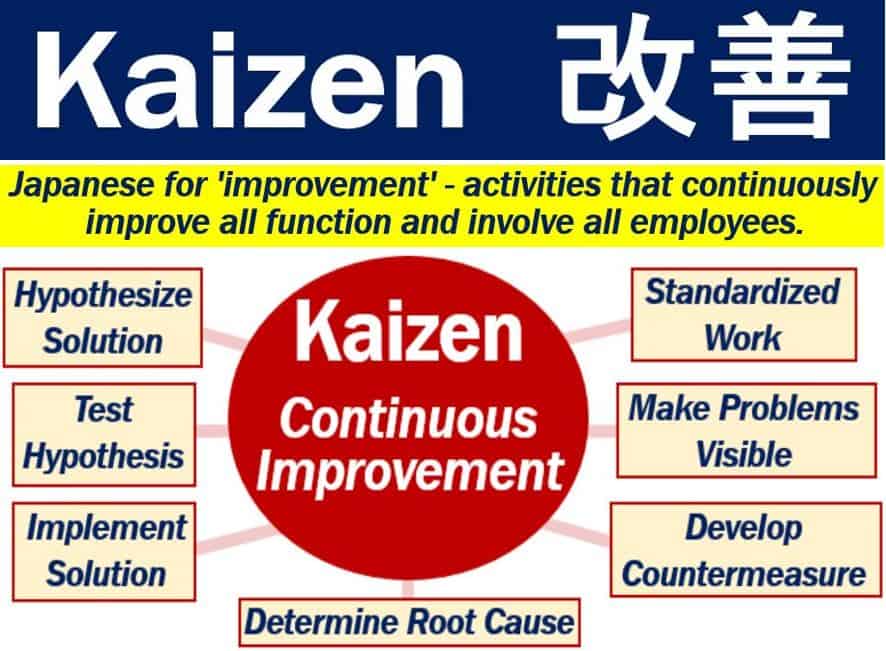Kaizen – definition and meaning
Kaizen, a Japanese word meaning change for the better, refers to taking small steps to improve a system. Usually, we apply it to processes such a logistics and processing. Specifically, we apply it to systems that cross organizational boundaries into the supply chain. It is a gradual approach to higher standards in quality improvement and the reduction of waste.
It is an approach we use in Lean Manufacturing.
With this approach, you aim for small but continual improvements and involve everybody in the company. In other words, you involve everybody from the CEO to the lowest-level unskilled workers. CEO stands for Chief Executive Officer.
It is, in fact, a combination of two words, ‘kai‘ and ‘zen.’ Kai means ‘repair, renew,’ and ‘change.’ The second part of the word, ‘zen,’ can mean ‘good’ as an adjective or ‘power, virtue’ as a noun.

Kaizen vs. Kaikaku
The term contrasts with Kaikaku, another Japanese word, which means ‘radical change, reform’ or ‘breakthrough.’
Kaikaku is a Lean Production term that introduces drastic changes. The approach aims to achieve significant improvements rapidly.
Doing Kaizen means changing things one at a time. You then observe the effects. In other words, you learn from experience.
Doing Kaikaku, however, means introducing drastic and major changes. Therefore, we consider Kaiku as the riskier of the two approaches.
In.Kaizen.com has the following definition of the term:
“Kaizen is the practice of continuous improvement. it is recognized worldwide as an important pillar of an organization’s long-term competitive strategy.”
People have applied this approach in manufacturing, healthcare, banking, and other industries. In fact, it has even been applied in life-coaching and psychotherapy.
Kaizen guiding principles
In.Kaizen.com adds that the approach has the following guiding principles:
- – Always work as a team.
- – It is everybody‘s business. For the approach to be successful, you need to make sure that every employee participates.
- – Good processes lead to good results.
- – To grasp the current situation, you have to go and see for yourself.
- – Identify the root cause of problems, and then take action and correct them.
- – Speak with data and manage by facts.
If you want big results you need to implement many small changes. If you keep implementing them, over time they accumulate and eventually become significant.
Many people think incorrectly that the term simply means small changes. In fact, it means that for improvements to really take hold, everybody has to do their bit.
In other words, you must involve everybody to achieve improvements.
In.Kaizen.com says:
“While the majority of changes may be small, the greatest impact may be Kaizens that are led by senior management as transformational projects, or by cross-functional teams as kaizen events.”
Video – What is Kaizen?
In this video, Matts Rehnstrom talks about the meaning of the word ‘Kaizen’ and where it came from.
He also explains that it is, in fact, a compound word. In other words, it is the result of joining at least two words together. In this case, the two words are ‘kai’ and ‘zen.’ He explains what ‘kai’ and ‘zen’ mean.

